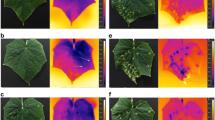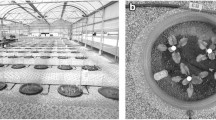Abstract
Phytopathogenic fungi may affect both the cuticular and the stomatal conductance of plant tissue resulting in significant modifications of leaf temperature. Venturia inaequalis colonizes apple leaves below the cuticle (subcuticularly) causing scab disease. The suitability of digital infrared thermography for sensing and quantifying apple scab was assessed by investigating the effects of V. inaequalis on the water balance of apple leaves in relation to the disease stage and the severity of scab. Transpiration was measured by infrared thermo-imaging to evaluate spatial heterogeneity of the leaves in response to localized infections. Fungal development was assessed microscopically. Subcuticular growth of the pathogen caused localized decreases in leaf temperature before symptoms appeared that significantly increased the maximum temperature difference (MTD) of leaves. The MTD increased with scab development and was strongly correlated to the size of infection sites (r²linear = 0.85) and overall disease severity (% diseased leaf area, r²square = 0.71). In later stages of the disease, the MTD decreased because of leaf senescence. Thermographic measurements revealed differences in disease severity resulting from disease stage, resistance of host tissue and differences in the aggressiveness of V. inaequalis isolates. Subcuticular growth of the pathogen was beyond the area of conidia production, therefore, the area of leaf with increased transpiration was larger than the scab lesions; the proportion decreased from >70% in the early stages to <20% for mature lesions. Leaf transpiration was increased by all stages of scab development, therefore, MTD may be used not only for the differentiation between diseased and non-diseased leaves, but also for disease quantification, e.g. in screening systems and monitoring in precision agriculture.







Similar content being viewed by others
References
Aderhold, R. (1896). Die Fusicladien unserer Obstbäume, 1. Teil. Diels Landwirtschaftliches Jahrbuch, 25, 875–914.
Allegre, M., Daire, X., Heloir, M. C., Trouvelot, S., Mercier, L., Adrian, M., et al. (2007). Stomatal deregulation in Plasmopara viticola-infected grapevine leaves. New Phytologist, 173, 832–840.
Ayres, P. G., & Jones, P. (1975). Increased transpiration and the accumulation of root absorbed 86Rb in barley leaves infected by Rhynchosporium secalis (leaf blotch). Physiological Plant Pathology, 7, 49–58.
Bassanezi, R. B., Amorim, L., Bergamin, F. A., & Berger, R. D. (2002). Gas exchange and emission of chlorophyll fluorescence during the monocycle of rust, angular leaf spot and anthracnose on bean leaves as a function of their trophic characteristics. Journal of Phytopathology, 150, 37–47.
Chaerle, L., Van Caeneghem, W., Messens, E., Lambers, H., van Montagu, M., & van der Straeten, D. (1999). Presymptomatic visualization of plant–virus interactions by thermography. Nature Biotechnology, 17, 813–816.
Chaerle, L., de Boever, F., van Montagu, M., & van der Straeten, D. (2001). Thermographic visualization of cell death in tobacco and Arabidopsis. Plant, Cell and Environment, 24, 15–25.
Chaerle, L., Hagenbeek, D., de Bruyne, E., Valcke, R., & van der Straeten, D. (2004). Thermal and chlorophyll-fluorescence imaging distinguish plant–pathogen interactions at an early stage. Plant Cell Physiology, 45, 887–896.
Corlett, M., Chong, J., & Kokko, E. G. (1976). The ultrastructure of the Spilocea state of Venturia inaequalis in vivo. Canadian Journal of Microbiology, 22, 1144–1152.
Delalieux, S., van Aardt, J., Keulemans, W., Schrevens, E., & Coppin, P. (2007). Detection of biotic stress (Venturia inaequalis) in apple trees using hyperspectral data: Non-parametric statistical approaches and physiological implications. European Journal of Agronomy, 27, 130–143.
Delalieux, S., Somers, B., Verstraeten, W. W., van Aardt, J. A. N., Keulemans, W., & Coppin, P. (2009). Hyperspectral indices to diagnose leaf biotic stress of apple plants, considering leaf phenology. International Journal of Remote Sensing, 30, 1887–1912.
Di Giorgio, D., Camoni, L., Mott, K. A., Takemoto, J. Y., & Ballio, A. (1996). Syringopeptins, Pseudomonas syringae pv. syringae phytotoxins, resemble syringomycin in closing stomata. Plant Pathology, 45, 564–571.
Fito, P. J., Ortola, M. D., de los Reyes, D., Fito, P., & de los Reyes, E. (2004). Control of citrus surface drying by image analysis of infrared thermography. Journal of Food Engineering, 61, 287–290.
Gessler, C., & Stumm, D. (1984). Infection and stroma formation by Venturia inaequalis on apple leaves with different degrees of susceptibility to scab. Phytopathologische Zeitschrift, 110, 119–126.
Hignett, R. C., & Kirkham, D. S. (1967). The role of extracellular melanoproteins in Venturia inaequalis in host susceptibility. Journal of General Microbiology, 48, 269–275.
Inoue, Y., Kimball, B. A., Jackson, R. D., Pinter, P. J., & Reginato, R. J. (1990). Remote estimation of leaf transpiration rate and stomatal resistance based on infrared thermometry. Agricultural and Forest Meteorology, 51, 21–33.
Jones, H. G. (1992). Plant and microclimate (2nd ed.). Cambridge, UK: Cambridge University Press.
Jones, H. G. (2004). Application of thermal imaging and infrared sensing in plant physiology and ecophysiology. Advances in Botanical Research, 41, 107–163.
Jones, H. G., Stoll, M., Santoa, T., de Sousa, C., Chaves, M. M., & Grant, O. M. (2002). Use of infrared thermography for monitoring stomatal closure in the field: Application to grapevine. Journal of Experimental Botany, 53, 2249–2260.
Kümmerlen, B., Dauwe, S., Schmundt, D., & Schurr, U. (1999). Thermography to measure water relations of plant leaves. In B. Jähne (Ed.), Handbook of computer vision and applications (Vol. 3, pp. 763–781). London: Academic Press.
Leinonen, I., & Jones, H. G. (2004). Combining thermal and visible imagery for estimating canopy temperature and identifying plant stress. Journal of Experimental Botany, 55, 1423–1431.
Leinonen, I., Grant, O. M., Tagliavia, C. P. P., Chaves, M. M., & Jones, H. G. (2006). Estimating stomatal conductance with thermal imagery. Plant, Cell and Environment, 29, 1508–1518.
Lenthe, J.-H., Oerke, E.-C., & Dehne, H.-W. (2007). Digital infrared thermography for monitoring canopy health of wheat. Precision Agriculture, 8, 15–26.
Lindenthal, M., Steiner, U., Dehne, H.-W., & Oerke, E.-C. (2005). Effect of downy mildew development on transpiration of cucumber leaves visualized by digital infrared thermography. Phytopathology, 95, 233–240.
Luquet, D., Begue, A., Vidal, A., Clouvel, P., Dauzat, J., et al. (2003). Using multidirectional thermography to characterize water status of cotton. Remote Sensing of Environment, 84, 411–421.
MacHardy, W. E. (1995). Apple scab: Biology, epidemiology, and management. St. Paul, MN: APS Press.
MacHardy, W. E., & Gadoury, D. M. (1989). A revision of Mills’s criteria for predicting apple scab infection periods. Phytopathology, 79, 304–310.
McDonald, K. L., & Cahill, D. M. (1999). Evidence for a transmissible factor that causes rapid stomatal closure in soybean at sites adjacent to and remote from hypersensitive cell death induced by Phytophthora sojae. Physiological and Molecular Plant Pathology, 55, 197–203.
Merlot, S., Mustilli, A. C., Genty, B., North, H., Lefebre, V., et al. (2002). Use of infrared thermal imaging to isolate Arabidopsis mutants defective in stomatal regulation. Plant Journal, 30, 601–609.
Mills, W. D. (1931). A method of detecting and demonstrating early leaf infections of apple scab. Phytopathology, 21, 338–339.
Möller, M., Alchanatis, V., Cohen, Y., Tsipris, J., Naor, A., et al. (2007). Use of thermal and visible imagery for estimating crop water status of irrigated grapevine. Journal of Experimental Botany, 58, 827–838.
Nusbaum, C. J., & Keitt, G. W. (1938). A cytological study of host-parasite relations of Venturia inaequalis on apple leaves. Journal of Agricultural Research (Washington), 56, 595–618.
Oerke, E.-C., Lindenthal, M., Fröhling, P., & Steiner, U. (2005). Digital infrared thermography for the assessment of leaf pathogens. In J. V. Stafford (Ed.), Precision agriculture ‘05 (pp. 91–98). Wageningen: Wageningen University Press.
Oerke, E.-C., Steiner, U., Dehne, H.-W., & Lindenthal, M. (2006). Thermal imaging of cucumber leaves affected by downy mildew and environmental conditions. Journal of Experimental Botany, 57, 2121–2132.
Pearce, R. S., & Fuller, M. P. (2001). Freezing of barley studied by infrared video thermography. Plant Physiology, 125, 227–240.
Prytz, G., Futsaether, C. M., & Johnsson, A. (2003). Thermography studies of the spatial and temporal variability in stomatal conductance of Avena leaves during stable and oscillatory transpiration. New Phytologist, 158, 258–259.
Schönherr, J. (1982). Resistance of plant surfaces to water loss: Transport properties of cutin, suberin and associated lipids. In Encyclopedia of plant physiology (Vol. 12B, pp. 153-179). Berlin: Springer-Verlag.
Shear, G. M., & Drake, C. R. (1971). Calcium accumulation in apple fruit infected with Venturia inaequalis (Cooke) Wint. Physiological Plant Pathology, 1, 313.
Smith, R. C. G., Heritage, A. D., Stapper, M., & Barrs, H. D. (1986). Effect of stripe rust (Puccinia striiformis West.) and irrigation on the yield and foliage temperature of wheat. Field Crops Research, 14, 39–51.
Stadelmann, F. X., & Schwinn, F. J. (1982). Contribution to the biology of Venturia inaequalis. Zeitschrift für Pflanzenkrankheiten und Pflanzenschutz, 89, 96–109.
Stajnko, D., Lakota, M., & Hoevar, M. (2004). Estimation of number and diameter of apple fruits in an orchard during the growing season by thermal imaging. Computers and Electronics in Agriculture, 42, 31–42.
Stenzel, I., Steiner, U., Dehne, H.-W., & Oerke, E.-C. (2007). Occurrence of fungal leaf pathogens in sugar beet fields monitored with digital infrared thermography. In J. V. Stafford (Ed.), Precision agriculture ‘07 (pp. 529–535). Wageningen: Wageningen Academic Publishers.
Stier, J. C., Filiault, D. L., Wisniewski, M., & Palta, J. P. (2003). Visualization of freezing progression in turfgrasses using infrared video thermography. Crop Science, 43, 415–420.
Stoll, M., Schultz, H. R., Baecker, G., & Berkelmann-Loehnertz, B. (2008a). Early pathogen detection under different water status and the assessment of spray application in vineyards through the use of thermal imagery. Precision Agriculture, 9, 407–417.
Stoll, M., Schultz, H. R., & Berkelmann-Loehnertz, B. (2008b). Exploring the sensitivity of thermal imaging for Plasmopara viticola pathogen detection in grapevines under different water status. Functional Plant Biology, 35, 281–288.
Wang, Y., Holroyd, G., Hetherington, A. M., & Ng, C. K. Y. (2004). Seeing ‘cool’ and ‘hot’-infrared thermography as a tool for non-invasive, high-throughput screening of Arabidopsis guard cell signaling mutants. Journal of Experimental Botany, 55, 1187–1193.
Wright, K. N., Duncan, G. H., Pradel, K. S., Carr, F., Wood, S., et al. (2000). Analysis of the N gene hypersensitive response induced by a fluorescently tagged tobacco mosaic virus. Plant Physiology, 123, 1375–1385.
Acknowledgments
We would like to thank Phil E. Russell for critical reading of a former version of the manuscript. We are grateful to Alexander Prange, Hochschule Niederrhein, Mönchengladbach (D) for providing the AquaLab CX-3.
Author information
Authors and Affiliations
Corresponding author
Rights and permissions
About this article
Cite this article
Oerke, EC., Fröhling, P. & Steiner, U. Thermographic assessment of scab disease on apple leaves. Precision Agric 12, 699–715 (2011). https://doi.org/10.1007/s11119-010-9212-3
Published:
Issue Date:
DOI: https://doi.org/10.1007/s11119-010-9212-3




